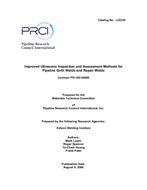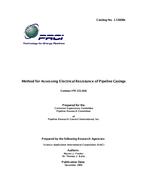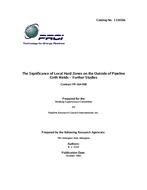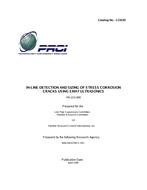Provide PDF Format
PRCI PR-164-9330
- Evaluation of Low Hydrogen Welding Processes for Pipeline Construction in High Strength Steel
- Report / Survey by Pipeline Research Council International, 08/01/1996
- Publisher: PRCI
$298.00$595.00
L51751e
The Welding Institute (UK)
Need: As the use of higher strength and thicker walled pipe becomes more prevalent, the procedures that would normally guard against hydrogen cracking when welding with cellulosic electrodes, become less effective and it has become necessary to investigate the use of alternative low hydrogen consumables. Low hydrogen manual welding processes, suitable for pipeline girth welding, have been available for some time for the lower strength pipe grades, and latterly, for high strength pipelines (up to and including X80). Despite their availability and advantages in terms of reduced crack susceptibility, they have been rarely used in production up to the present time. Basic coated shielded metal arc (SMA) electrodes, suitable for vertical-down welding, are produced by some manufacturers at the strength level required for both the root welding and filling of pipeline girth welds. Self-shielded flux-cored wires (SSFCA) are also available for both root and fill welding, and in addition to the low hydrogen levels, these have the advantage of increased productivity. Both of these processes require different methods of deposition compared to welding using cellulosic electrodes, which necessitates specialized training of welders. It is thought that this, along with doubts concerning the reliability and speed of the processes in site conditions, has made contractors reluctant to adopt them. Furthermore, there was a dearth of independently produced information on the welding production performance of low hydrogen processes.
Result: The objectives of this work was to generate data to enable users to make an informed judgement regarding the practical application of low hydrogen processes. Furthermore, it was intended to develop improved root welding procedures, which had been recognized as being significant process limitation. A further objective of this work was to collect data to permit an informed choice when choosing low hydrogen welding processes for modern high-strength steel walled pipe. The performance of low hydrogen vertical down electrodes (L4VD) and solid and flux cored wires for welding X80 linepipe is assessed with regard to ease of welding, productivity and weldment mechanical properties in comparison to cellulosic electrodes.
Benefit: Improved root welding procedures when using low hydrogen processes and more accurate determination of comparative cracking susceptibilities of candidate welding procedures.
The Welding Institute (UK)
Need: As the use of higher strength and thicker walled pipe becomes more prevalent, the procedures that would normally guard against hydrogen cracking when welding with cellulosic electrodes, become less effective and it has become necessary to investigate the use of alternative low hydrogen consumables. Low hydrogen manual welding processes, suitable for pipeline girth welding, have been available for some time for the lower strength pipe grades, and latterly, for high strength pipelines (up to and including X80). Despite their availability and advantages in terms of reduced crack susceptibility, they have been rarely used in production up to the present time. Basic coated shielded metal arc (SMA) electrodes, suitable for vertical-down welding, are produced by some manufacturers at the strength level required for both the root welding and filling of pipeline girth welds. Self-shielded flux-cored wires (SSFCA) are also available for both root and fill welding, and in addition to the low hydrogen levels, these have the advantage of increased productivity. Both of these processes require different methods of deposition compared to welding using cellulosic electrodes, which necessitates specialized training of welders. It is thought that this, along with doubts concerning the reliability and speed of the processes in site conditions, has made contractors reluctant to adopt them. Furthermore, there was a dearth of independently produced information on the welding production performance of low hydrogen processes.
Result: The objectives of this work was to generate data to enable users to make an informed judgement regarding the practical application of low hydrogen processes. Furthermore, it was intended to develop improved root welding procedures, which had been recognized as being significant process limitation. A further objective of this work was to collect data to permit an informed choice when choosing low hydrogen welding processes for modern high-strength steel walled pipe. The performance of low hydrogen vertical down electrodes (L4VD) and solid and flux cored wires for welding X80 linepipe is assessed with regard to ease of welding, productivity and weldment mechanical properties in comparison to cellulosic electrodes.
Benefit: Improved root welding procedures when using low hydrogen processes and more accurate determination of comparative cracking susceptibilities of candidate welding procedures.
Related Products
PRCI PR-185-04500
Ultrsonic Inspection of Hot Tap Branch Connections and Weld Sleeve-Fillet Weld using Phased Arrays..
$98.00 $195.00
PRCI PR-164-008
The Significance of Local Hard Zones on the Outside of Pipeline Girth Welds - Further Studies..
$98.00 $195.00
PRCI PR-155-909
In-Line Detection and Sizing of Stress Corrosion Cracks Using EMAT Ultrasonics..
$125.00 $249.00





